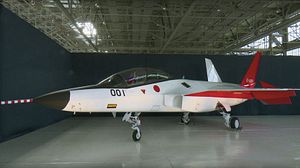Mitsubishi Heavy Industries’ experimental fifth-generation fighter technology demonstrator X-2 “Shinshin” (formerly the ATD-X) will make its maiden flight in late April, according to sources within Japan’s new Acquisition, Technology, and Logistics Agency (ATLA), Nikkei Asian Review reports.
Flight testing of Japan’s first indigenously-designed fifth-generation air superiority fighter prototype was originally slated to begin in the middle of February 2016. However, safety concerns and prolonged taxiing and ground trials have delayed the maiden flight of the new aircraft, according to senior executives of ATLA.
Problems with the engine control software in particular were a concern for the engineers working on the X-2. The aircraft will feature 3D thrust vectoring capability and an axis-symmetric thrust vectoring engine that will increase the maneuverability of the X-2.
The X-2’s first flight will take the technology demonstrator from the Mitsubishi testing center in Aichi Prefecture to Gifu Air Field, an airbase of the Japan Air Self-Defense Force, situated in the neighboring prefecture of Gifu. It would be the first indigenously-designed Japanese fighter jet to take off since the 1940s.
The developers of the X-2 have been satisfied with the program’s progress until now. In March an ATLA representative said in an email that “[t]he aircraft is performing well so far. We are proceeding with tests, performing very careful maintenance, and making some minor adjustments.”
As I explained previously (See: “Japan’s 5th Generation Stealth Fighter to Make Maiden Flight in Early 2016”):
The principal objective of the ATD-X Shinshin program is to develop a research prototype aircraft — an“advanced technology demonstration unit” — to test the capacity of Japan’s defense industry to develop, among other things, a powerful fighter engine and various other indigenous stealth fighter aircraft technologies.
The end goal of the X-2 program is to produce Japan’s first indigenously-designed fifth-generation air superiority fighter, the F-3, by 2027. The X-2 prototype is slated for completion by 2018. Only one full-scale X-2 prototype has been constructed so far. Given Japan’s shortage in fighter aircraft (See: “Is Japan Facing a Shortage of Fighter Aircraft?”), Japan will procure 42 F-35 Lightning II Joint Strike Fighters as an interim solution over the next few years.
I explained previously:
The reason behind the development of the F-3 is the refusal of the United States to sell to Japan the Lockheed-Martin F-22 Raptor stealth air superiority fighter in the 2000s. According to some media reports, Lockheed-Martin is playing an undetermined role in the development of the ATD-X prototype.
Japan currently operates 94 Mitsubishi F-2s, a 4.5 generation multirole fighter based on Lockheed Martin’s F-16, 70 F-4 Phantom II jets, and around 223 license-built F-15 all-weather air superiority fighters.
































